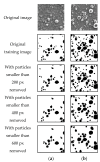U-Net-Based Segmentation of Microscopic Images of Colorants and Simplification of Labeling in the Learning Process
- PMID: 35877621
- PMCID: PMC9318575
- DOI: 10.3390/jimaging8070177
U-Net-Based Segmentation of Microscopic Images of Colorants and Simplification of Labeling in the Learning Process
Abstract
Colored product textures correspond to particle size distributions. The microscopic images of colorants must be divided into regions to determine the particle size distribution. The conventional method used for this process involves manually dividing images into areas, which may be inefficient. In this paper, we have overcome this issue by developing two different modified architectures of U-Net convolution neural networks to automatically determine the particle sizes. To develop these modified architectures, a significant amount of ground truth data must be prepared to train the U-Net, which is difficult for big data as the labeling is performed manually. Therefore, we also aim to reduce this process by using incomplete labeling data. The first objective of this study is to determine the accuracy of our modified U-Net architectures for this type of image. The second objective is to reduce the difficulty of preparing the ground truth data by testing the accuracy of training on incomplete labeling data. The results indicate that efficient segmentation can be realized using our modified U-Net architectures, and the generation of ground truth data can be simplified. This paper presents a preliminary study to improve the efficiency of determining particle size distributions with incomplete labeling data.
Keywords: U-Net; colorants; deep learning; labeling; particle size distribution; segmentation.
Conflict of interest statement
The authors declare no conflict of interest.
Figures












References
-
- Kilcast D., Clegg S. Sensory perception of creaminess and its relationship with food structure. Food Qual. Prefer. 2002;13:609–623. doi: 10.1016/S0950-3293(02)00074-5. - DOI
-
- Gueli A.M., Bonfiglio G., Pasquale S., Troja S.O. Effect of particle size on pigments colour. Color Res. Appl. 2017;42:236–243. doi: 10.1002/col.22062. - DOI
-
- Nobuoka S. The Relation between Particle Size and Shape of the Pigments and Optical Property. J. Jpn. Soc. Colour Mater. 1982;55:758–765. doi: 10.4011/shikizai1937.55.758. - DOI
LinkOut - more resources
Full Text Sources

